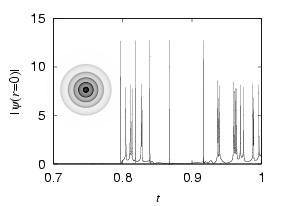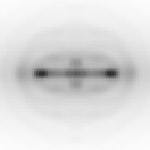Intermittent implosion and pattern formation of BEC with attractive
interactions
Bose-Einstein condensation (BEC) of trapped atomic vapor has been realized
in several atomic species.
The static and dynamical properties of BEC crucially depend on the sign of
the interatomic interaction.
When the interaction is attractive, BEC in a spatially uniform
3D system is unstable to collapse into a denser phase.
Both the strength and the sign of the interaction can be controlled
by varying the s-wave scattering length of atoms near the Feshbach
resonance.
In recent experiments at JILA, BEC with repulsive interaction is first
prepared, and then the interaction is switched to attractive, observing
the collapse of BEC.
Here, we predict two new phenomena associated with the collapse
of BEC in such situation.
One is the pattern formation in atomic density, which
follows sudden switch in the sign of the interaction from repulsive to
attractive.
 animation of collapse
animation of collapse
The grayscale image in the figure shows the column density of one million
atoms at t = 0.79, where the s-wave scattering length is changed from
2.8 nm to -1 nm at t = 0 and the BEC evolves obeying the
Gross-Pitaevskii equation.
The concentric circles shows the formation of the shell structure in the
atomic density.
This phenomenon occurs because density fluctuations caused by the
change in the sign of the interaction grow and self-focus due to the
attractive interaction.
The other prediction is intermittent implosion .
In the figure, there are large five peaks which correspond to implosion of
each shell arriving at the center of the trap one by one.
Between and after them, the small and irregular peaks arise in rapid
sequence, which is the intermittent implosion.
This phenomenon is caused by competition between the accumulation of
atoms due to the attractive interaction and the loss of atoms by inelastic
collisions.
Formation of "jets"
In the JILA experiment, collapse of a BEC caused very interesting phenomena:
atomic bursts and jets.
We performed numerical simulations of the experiment and succeeded in
reproducing these phenomena (PRA 65, 033624 (2002)).
The "jets" seem to be very anisotropic atomic flows perpendicular to the trap
axis, which occurs when the interaction is changed from attractive to repulsive
in the course of the collapse.
However, we found that the jet is not an anisotropic flow but an interference
pattern.
During the collapse, there are typically more than one local spike in the atomic
density, as shown below.

When the interaction is changed to repulsive, the matter wave emanates from each
density spike and overlaps each other.
Jet formation
(GIF, 805KB)
(WMV, 84KB)
Thus, the jet is not an anisotropic atomic flow but the intereference between
isotropic atomic flows from two or more points.
Back
 animation of collapse
animation of collapse 